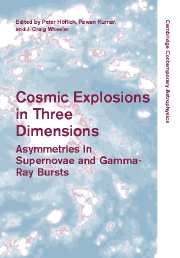Book contents
- Frontmatter
- Contents
- Part I Introduction
- Part II Supernovae: Observations Today
- Part III Theory of Thermonuclear Supernovae
- Part IV Theory of Core Collapse Supernovae
- 22 Rotation in core collapse progenitors: single and binary stars
- 23 Large scale convection and the convective supernova mechanism
- 24 Topics in core-collapse supernova-theory
- 25 MHD supernova jets: the missing link
- 26 Effects of super-strong magnetic fields in a core collapse supenova
- 27 Non-radial instability of stalled accretion shocks: advective-acoustic cycle
- 28 Asymmetry effects in hypernovae
- 29 Stellar abundances: the r-process and supernovae
- Part V Magnetars, N-Stars, Pulsars
- Part VI Gamma-ray Bursts
- Part VII Conference Summary
- References
27 - Non-radial instability of stalled accretion shocks: advective-acoustic cycle
Published online by Cambridge University Press: 11 August 2009
- Frontmatter
- Contents
- Part I Introduction
- Part II Supernovae: Observations Today
- Part III Theory of Thermonuclear Supernovae
- Part IV Theory of Core Collapse Supernovae
- 22 Rotation in core collapse progenitors: single and binary stars
- 23 Large scale convection and the convective supernova mechanism
- 24 Topics in core-collapse supernova-theory
- 25 MHD supernova jets: the missing link
- 26 Effects of super-strong magnetic fields in a core collapse supenova
- 27 Non-radial instability of stalled accretion shocks: advective-acoustic cycle
- 28 Asymmetry effects in hypernovae
- 29 Stellar abundances: the r-process and supernovae
- Part V Magnetars, N-Stars, Pulsars
- Part VI Gamma-ray Bursts
- Part VII Conference Summary
- References
Summary
Abstract
The linear stability of stalled accretion shocks is investigated in the context of core collapse of type II supernovae. We focus on a particular instability mechanism based on the coupling of acoustic perturbations with advected ones (vorticity, entropy). This advective-acoustic cycle takes place between the shock and the nascent neutron star. Both adiabatic and non-adiabatic processes may contribute to this coupling, but only adiabatic ones are considered in this first approach. The growth time of the adiabatic instability scales like the advection time, and is dominated by low degree modes l = 0,1,2. Non radial modes (l = 1,2) found unstable by Blondin et al. (2003) can be related to this mechanism.
Introduction
Shocked accretion onto the surface of a compact star is known to be unstable in the context of magnetized white dwarfs, leading to shock oscillations (from Langer, Chanmugam & Shaviv 1981, hereafter LCS81, to Saxton & Wu 2001). Houck & Chevalier (1992, hereafter HC92) made a linear stability analysis of shocked accretion onto a neutron star, and found an instability reminiscent of the instability found by LCS81. HC92 showed specific cases where the cooling occurs mostly in a thin layer at the surface of the neutron star, while the flow is essentially adiabatic above it. The mechanism of the instability was described by LCS81 and subsequent authors as a kind of thermal instability: if the shock surface is moving outwards, the higher incident velocity in the frame of the shock produces a higher temperature blob, which pushes the shock further out if the increased cooling time exceeds the increased advection time.
- Type
- Chapter
- Information
- Cosmic Explosions in Three DimensionsAsymmetries in Supernovae and Gamma-Ray Bursts, pp. 238 - 243Publisher: Cambridge University PressPrint publication year: 2004
References
- 3
- Cited by



